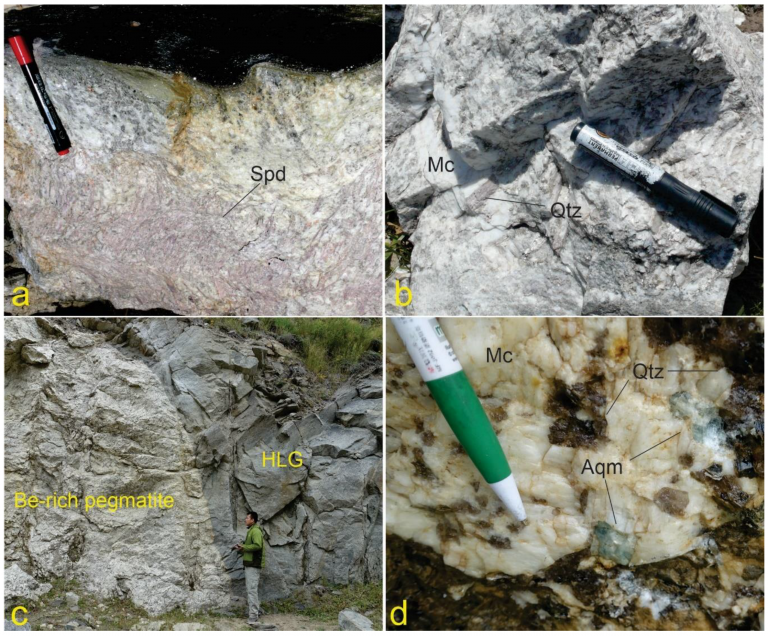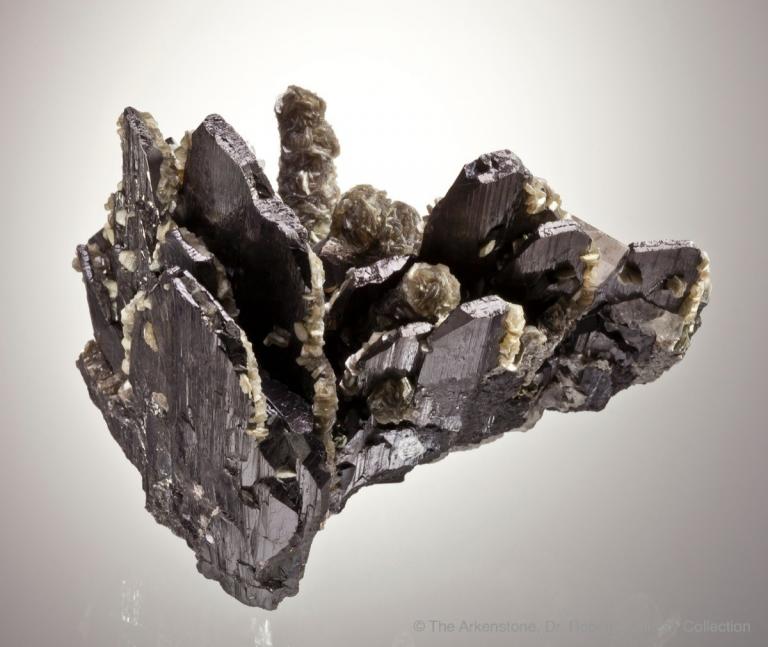Non Metallic minerals in xinjiang
7 min readThe nonmetallic mineral exploration in Xin jiang almost covers all auxiliary metallurgical materials, chemicals, building materials and other non-metallic minerals and gemstones. The mainly explored and used 72 types of nonmetallic minerals include halite, Glauber’s salt, sylvite, vermiculite, asbestos, bentonite, mica, limestone, gypsum, buildingsand, clay, granite, silica raw material, etc. Among them, there are 11 types of chemicals nonmetallic mineral, mainly including sylvite, natratine, Glauber’s salt, halite, pyrite, barite, etc. There are 61 types of nonmetallic minerals for metallurgy and building and other nonmetallic minerals mainly including granite, asbestos, white mica, vermiculite, andalusite, limestone, gypsum, bentonite, glass silica raw material, building sand, clay, etc., which widely distribute in Xinjiang.
The nonmetallic minerals in Xin jiang are mainly located at the south foot of Altai Mountains, Junggar Basin rim, Tarim Basin rim, and the eastern and western Tianshan Mountains according to geological mineralization conditions. The nonmetallic minerals in Xinjiang are various in types, rich and widely distributed with great resource potential, and play important role in the overall development of resources.
Various types and large reserves. Now there are 121 varieties of useful minerals are found in Xinjiang, accounting for 80% of those in China, among which there are 43 types of ferrous metals, noble metals, and rare elements while there are 78 types of nonmetallic minerals(7 kinds of energy minerals,21 kinds of chemicals nonmetallic minerals,50 special types of nonmetallic minerals). As for building stones, over 50 marble spots and over 30granite spots are found with industrial meaning with an estimate geological reserve ofabout 1 billion m³. Some minerals are very famous in Xin jiang, in China and even in the world. Mica is an advantageous product in Xinjiang whose reserve accounts for 70% of that in China and production volume is half of that in China. Quality vermiculite ores are found in Weili County in northern part of Tarim with reserves of over 130 million tons and sold to Europe, America and Japan. Xinjiang has a widely distributed ultrabasic rocks and a large amount of serpentine rock resources topping in China in reserves. Serpentine rocks for fertilizer use include serpentine rock and oilivine used for calcium magnesium phosphate and as the raw material for extracting magnesium compound and epsom salt. Bentonite is distributed in the rim of Junggar Basin and Toksun. Hoboksar Bentoniter is an extra large deposit in China and is the only bentonite mineral in China which meets the USA mud API standard. Asbestos is distributed in Altun Mountain and Yushugou in Tianshan Mountains, among which Altun Mountain is the largest asbestos mineralization zone and Yitunbulake Stone Mine is the second largest asbestos mine in China. Xin jiang Glauber’s salt has large reserves, high quality and a good market. Bentonite is a rare and precious mineral resource in the world. Several soapstone mines are found in Xin jiang, among which Yushugou soapstone ore in Toksun County is the first soapstone ore found in China and tested tohave good quality and its quality can meet the Veegum requirement for the hectorite in America and the ascertained reserves are over 1 million tons. Magnesite reserves in Xinjiang rank fourth in China and Xinjiang is also rich in sulfur, talc, limestone, mineral salts. There are relatively plentiful gens with some popularity.

Resources widely distribute and concentrate and the exploration and transporting conditions are good. Weiya-Star Gorge in Kumul is a concentrated distribution area of building stones with large reserves, many varieties and good quality, topping in China. The transportation is convenient and the main mines are only 30 miles away from the railways.The granites in Bole, Tuoli have unique features and very convenient exploiting conditions.The Keer Alkali Sodium Base Bentonite ore, the largest one in Xinjiang and some Glauber’s salt export base are all along the Lan-xin Railway and its branches. Some famous mines such as Burqin current beach talcum mine, Xiazi Street Bentonite Mine in Bukesaier, Altai White Mica Ore Belt have great exploitation potential with the development of railways and roads.
In terms of resource reserves, development condition, mine finding prospect and market demand at home and abroad, the nonmetallic mineral resources in Xinjiang can be divided into three states of affairs:
The first ones are advantageous nonmetallic minerals. Vermiculite, muscovite, crushed mica, bentonite, asbestos, talc, gypsum, limestone, stone, Glauber’s salt, sodium saltpeter, lake salt, feldspar and serpentine, etc. These minerals are rich in reserves with many minerals ranking top in China and most have relatively good conditions for development and utilization to meet the requirement of Xin jiang for construction.A large part of these nonmetallic minerals are traditionally sold at home and abroad.
The second ones are general nonmetallic minerals. Pyrophyllite, zeolite, kaolin, graphite, barite, silica raw material, expanded perlite raw material, haydite materials, rock-wool-making raw materials, stone-cast-making raw materials, etc. All they have some proved reserves and geological reserves, and because of late prospecting, the prospects of several types of minerals are to be surveyed and also have the problem of undesirable ore varieties, taste and quality. And the utilization value is low and overall assessment has not been conducted. Therefore, large exploration and utilization are still cannot be conducted now.
The third ones are short nonmetallic minerals. Gem stone, bentonite, diatomite, wollastonite, fluorite, diamond, potash, trona, magnesite, kyanite, sillimanite, andalusite, sepiolite, punch sticks stones and diopside. There is serious shortage in the reserves of the above nonmetallic minerals.
Vermiculite
The only vermiculite deposit in Xin jiang is Qeganbulak vermiculite-apatite deposit in Weili County which is the largest vermiculite deposit in China at present.
Bentonite
Xinjiang has abundant bentonite resources. There are two deposits with one being the extra-large deposit and the other large deposit. The ascertained reserve accounts for 20.6% of that in China and 79.0% of that in northwestern China, ranking first in all Chinese provinces. Recent years, some bentonite minerals are also found successively in counties such as Fuyun County, Fuhai County, Habahe County, Kuqa County and Kuping County, etc.
Graphite
There are over 80 known graphite deposits and mineralization sites in Xin jiang, among which ten mineral points have some prospective reserves and the other 70 points do not have industrial significance due to small scale or low grade. Qitai and Kumul are the main production areas.
Soapstone
There are 5 soapstone deposits with proved reserves and proved industrial meaning in Xin jiang, mainly including Ultrabasic rock type alteration deposits and rich magnesiacarbonate hydrothermal metasomatic type. Soapstone deposits Hailiutan of Burqin County and Kumishi of Toksun County are the most famous ones, and the following are Molati Gully Mouth of Korla City and Kulande Gully of Toli County and Zhahe River dike in Fuyun County with geological reserves of over 2.60 million tons. Moreover, there are another three small mineral occurrences, namely, Kegangakeqi River soapstone mineral occurrence in Shache County, Mulberry Tree Garden soapstone mineral occurrence in Toksun County and Willow Gully soapstone mineral occurrence in Karamay City.
Asbestos
Xinjiang has relatively rich asbestos resources and is an important asbestos area in China. There are 6 proved asbestos mines in Xin jiang, ranking third behind Sichuan and Qinghai in China. There are four asbestos production areas with geological reserves and another 15 mineralization points without industrial significance. Asbestos deposits with industrial significance mainly concentrate in Alkin ore forming belt and others dispersedly distribute.
The best asbestos deposits with industrial significance in Xinjiang are Yitunbulake Town in Ruoqiang County and Apa of Qiemo County whose features are large deposit, high fiber content of asbestos ore, stable mineralization and long fiber; followed by Elm Gullyin Toksun County which has a large deposit, relatively high fiber content of asbestos ore and short fiber without stable mineralization.
Now in Xinjiang, four Counties of Ruoqiang, Qiemo, Toksun, and Toli and some legion farms with over 4,000 people are exploring asbestos with an annual output of 20,000~50,000 tons. Asbestos mine in Ruoqiang County and legion 36 asbestos mine are nationally key mines.
Limestone
Xinjiang has rich limestone resources with a wide area and a long-term production.They distribute in the irregular shape of “E”from Altai Mountains, Tianshan Mountains and Kunlun Mountains.
Silica raw material
Silica raw material in Xin jiang is relative plentiful with many mines and wide distribution and complete varieties. Among the 84 known deposits(spots), there are 59 vein quartz mines,8 quartzite mines,11 quartz sandstone mines and 6 quartz sand mines.
Kaolin
Kaolin future reserves in Xin jiang rank first in China. Now more than 60 kaolin mines are found in Xin jiang with various ores most of which are sandy kaolin and silt kaolin with relative low aluminum content and relative high silicon and ferrum content.
Gypsum
Gypsum mines widely distribute in Xin jiang. Now more than 70 Gypsum mineral occurrences are found mainly in the rim lands of Tarim Basin with Turpan, Kuqa, Yengisar County, Pishan County having the largest reserves and accounting for over 80% of the total reserves in Xinjiang Autonomous Region. Moreover, Altun Mountains and Kunlun Mountains also have plentiful reserves. The gypsum ores in Xin jiang have the followingfeatures:(1) Large deposit. Many of the found ores are large mines and extra large mines and there are several mines with reserves of dozens of million tons and hundreds of million tons. Some ore bodies are as long as more than ten kilometers and dozens of kilometers with reserves of several billion tons, which is rare in China.(2) Thick ledge. Some ordinary deposits are as thick as several meters, more than ten meters, dozens of meters, and some ordinary deposits are as thick as over 400 m, which is rare in China.(3)A complete ofvarieties.(4) Good quality and high content of calcium sulfate. The content of calcium sulfate of some gypsum ores can reach 85% in Korla area of Southern Xinjiang. The proven large gypsum ores of nearly one hundred million tons or over one hundred million tons in Xinjiang are: Tiemiersu gypsum ore and Tieliekesu gypsum ore in Wushi County, Aigeliumugypsum ore and Aertashi gypsum ore in Shache County, Kangsu gypsum ore in Ulugqat, etc.Gypsum can be used as fertilizer in agriculture to improve alkaline soil, and used in acid and neutral soil to improve soil structure and feed the elements of calcium and sulphur. The gypsum in Xin jiang has not been utilized efficiently and now is used as the burdening for cement.
Xin jiang is one of provinces with the most abundant mineral resources in China. It haslarge development prospect, and can be built into petroleum and chemical industry base, coal and coal chemical industry base, salt and salt chemical base, as well as non-ferrous and rare metals base with national significance.









